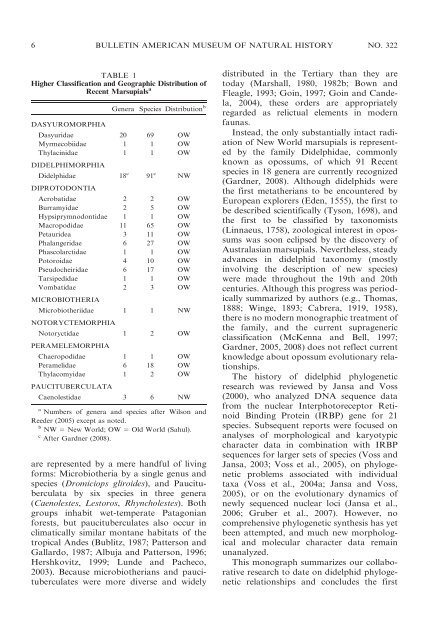phylogenetic relationships and classification of didelphid marsupials ...
phylogenetic relationships and classification of didelphid marsupials ...
phylogenetic relationships and classification of didelphid marsupials ...
You also want an ePaper? Increase the reach of your titles
YUMPU automatically turns print PDFs into web optimized ePapers that Google loves.
6 BULLETIN AMERICAN MUSEUM OF NATURAL HISTORY NO. 322<br />
TABLE 1<br />
Higher Classification <strong>and</strong> Geographic Distribution <strong>of</strong><br />
Recent Marsupials a<br />
Genera Species Distribution b<br />
DASYUROMORPHIA<br />
Dasyuridae 20 69 OW<br />
Myrmecobiidae 1 1 OW<br />
Thylacinidae<br />
DIDELPHIMORPHIA<br />
1 1 OW<br />
Didelphidae 18 c<br />
91 c<br />
DIPROTODONTIA<br />
NW<br />
Acrobatidae 2 2 OW<br />
Burramyidae 2 5 OW<br />
Hypsiprymnodontidae 1 1 OW<br />
Macropodidae 11 65 OW<br />
Petauridea 3 11 OW<br />
Phalangeridae 6 27 OW<br />
Phascolarctidae 1 1 OW<br />
Potoroidae 4 10 OW<br />
Pseudocheiridae 6 17 OW<br />
Tarsipedidae 1 1 OW<br />
Vombatidae<br />
MICROBIOTHERIA<br />
2 3 OW<br />
Microbiotheriidae<br />
NOTORYCTEMORPHIA<br />
1 1 NW<br />
Notoryctidae<br />
PERAMELEMORPHIA<br />
1 2 OW<br />
Chaeropodidae 1 1 OW<br />
Peramelidae 6 18 OW<br />
Thylacomyidae<br />
PAUCITUBERCULATA<br />
1 2 OW<br />
Caenolestidae 3 6 NW<br />
a<br />
Numbers <strong>of</strong> genera <strong>and</strong> species after Wilson <strong>and</strong><br />
Reeder (2005) except as noted.<br />
b<br />
NW 5 New World; OW 5 Old World (Sahul).<br />
c After Gardner (2008).<br />
are represented by a mere h<strong>and</strong>ful <strong>of</strong> living<br />
forms: Microbiotheria by a single genus <strong>and</strong><br />
species (Dromiciops gliroides), <strong>and</strong> Paucituberculata<br />
by six species in three genera<br />
(Caenolestes, Lestoros, Rhyncholestes). Both<br />
groups inhabit wet-temperate Patagonian<br />
forests, but paucituberculates also occur in<br />
climatically similar montane habitats <strong>of</strong> the<br />
tropical Andes (Bublitz, 1987; Patterson <strong>and</strong><br />
Gallardo, 1987; Albuja <strong>and</strong> Patterson, 1996;<br />
Hershkovitz, 1999; Lunde <strong>and</strong> Pacheco,<br />
2003). Because microbiotherians <strong>and</strong> paucituberculates<br />
were more diverse <strong>and</strong> widely<br />
distributed in the Tertiary than they are<br />
today (Marshall, 1980, 1982b; Bown <strong>and</strong><br />
Fleagle, 1993; Goin, 1997; Goin <strong>and</strong> C<strong>and</strong>ela,<br />
2004), these orders are appropriately<br />
regarded as relictual elements in modern<br />
faunas.<br />
Instead, the only substantially intact radiation<br />
<strong>of</strong> New World <strong>marsupials</strong> is represented<br />
by the family Didelphidae, commonly<br />
known as opossums, <strong>of</strong> which 91 Recent<br />
species in 18 genera are currently recognized<br />
(Gardner, 2008). Although <strong>didelphid</strong>s were<br />
the first metatherians to be encountered by<br />
European explorers (Eden, 1555), the first to<br />
be described scientifically (Tyson, 1698), <strong>and</strong><br />
the first to be classified by taxonomists<br />
(Linnaeus, 1758), zoological interest in opossums<br />
was soon eclipsed by the discovery <strong>of</strong><br />
Australasian <strong>marsupials</strong>. Nevertheless, steady<br />
advances in <strong>didelphid</strong> taxonomy (mostly<br />
involving the description <strong>of</strong> new species)<br />
were made throughout the 19th <strong>and</strong> 20th<br />
centuries. Although this progress was periodically<br />
summarized by authors (e.g., Thomas,<br />
1888; Winge, 1893; Cabrera, 1919, 1958),<br />
there is no modern monographic treatment <strong>of</strong><br />
the family, <strong>and</strong> the current suprageneric<br />
<strong>classification</strong> (McKenna <strong>and</strong> Bell, 1997;<br />
Gardner, 2005, 2008) does not reflect current<br />
knowledge about opossum evolutionary <strong>relationships</strong>.<br />
The history <strong>of</strong> <strong>didelphid</strong> <strong>phylogenetic</strong><br />
research was reviewed by Jansa <strong>and</strong> Voss<br />
(2000), who analyzed DNA sequence data<br />
from the nuclear Interphotoreceptor Retinoid<br />
Binding Protein (IRBP) gene for 21<br />
species. Subsequent reports were focused on<br />
analyses <strong>of</strong> morphological <strong>and</strong> karyotypic<br />
character data in combination with IRBP<br />
sequences for larger sets <strong>of</strong> species (Voss <strong>and</strong><br />
Jansa, 2003; Voss et al., 2005), on <strong>phylogenetic</strong><br />
problems associated with individual<br />
taxa (Voss et al., 2004a; Jansa <strong>and</strong> Voss,<br />
2005), or on the evolutionary dynamics <strong>of</strong><br />
newly sequenced nuclear loci (Jansa et al.,<br />
2006; Gruber et al., 2007). However, no<br />
comprehensive <strong>phylogenetic</strong> synthesis has yet<br />
been attempted, <strong>and</strong> much new morphological<br />
<strong>and</strong> molecular character data remain<br />
unanalyzed.<br />
This monograph summarizes our collaborative<br />
research to date on <strong>didelphid</strong> <strong>phylogenetic</strong><br />
<strong>relationships</strong> <strong>and</strong> concludes the first

















